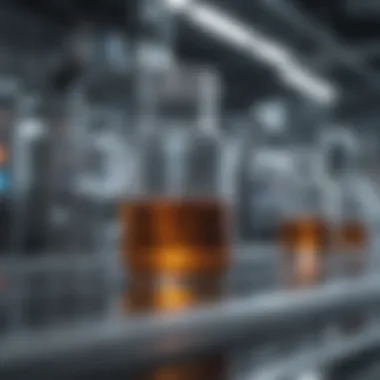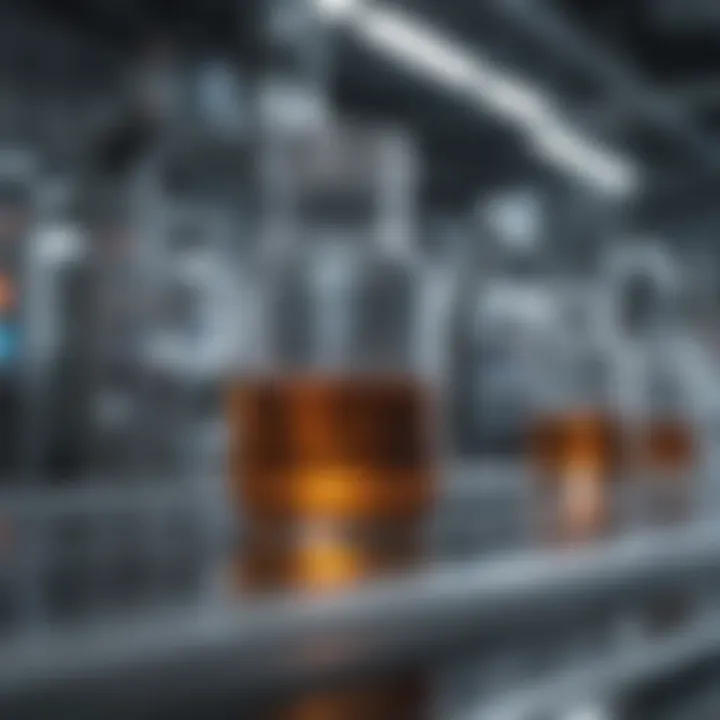The Impact of Pharma Reactors on Drug Development


Intro
Pharmaceutical reactors are critical components in the drug development journey. They serve as the sites where complex chemical reactions occur, enabling the synthesis of active pharmaceutical ingredients (APIs). These reactors facilitate various processes including mixing, heating, cooling, and more, which are essential for producing high-quality drugs. With advancements in technology, the design and efficiency of these reactors have evolved significantly, impacting the overall pharmaceutical manufacturing landscape.
The modern pharmaceutical industry demands a deep understanding of reactor types and their applications. Knowledge in this area is paramount for students, researchers, and professionals aiming to enhance their grasp of pharmaceutical sciences. This article seeks to offer a comprehensive overview of the role that pharma reactors play, discussing their functions, types, design considerations, and recent technological advancements.
Through this exploration, we aim to underscore the importance of effective reactor systems for improving manufacturing efficiencies and maintaining product quality. Consequently, this understanding will empower readers to appreciate the intricate relationship between reactor design and drug development processes.
Key Findings
Pharmaceutical reactors represent an intersection of chemistry, engineering, and technology. The following key findings elucidate their role in modern drug development:
- Diverse Types: There are various types of reactors, including batch reactors, continuous reactors, and multi-purpose reactors, each with distinct benefits depending on the specific APIs being produced.
- Functionality: Reactors not only enable the synthesis of APIs but also optimize the reaction conditions to enhance yield and reduce processing times.
- Impact of Technology: Advances in automation and process control technologies are leading to more efficient and reliable reactors, which, in turn, improve the scalability of pharmaceutical production.
"The integration of new technologies in pharma reactors has created pathways for enhanced productivity and reduced error rates in drug manufacturing."
Major Results
The significance of properly designed reactors is clear in both production capacity and product reliability. Evidence suggests that:
- Efficient reactor systems can reduce production costs significantly, leading to better market competitiveness for pharmaceutical companies.
- Continual improvement in reactor technologies facilitates compliance with stringent regulatory standards, ensuring drug safety and efficacy.
Discussion of Findings
A discussion surrounding the results emphasizes the necessity of ongoing research and development in reactor technology. As pharmaceutical needs evolve, so do the requirements for reactor performance. Companies must prioritize investing in cutting-edge technology to not only meet current demands but also anticipate future challenges within the industry.
Methodology
Research Design
To gather insights on pharmaceutical reactors, a qualitative research design was employed. This involved reviewing existing literature, industry reports, and case studies to provide a comprehensive understanding of the subject.
Data Collection Methods
The data collection methods included:
- Systematic literature reviews from academic journals focusing on pharmaceutical engineering.
- Interviews and surveys conducted with industry professionals to gain firsthand insights into the reactor technologies currently in use.
- An analysis of recent technological advancements in pharma reactors through credible online resources.
These methodologies ensured a well-rounded exploration of the role of pharma reactors, contributing to a deeper understanding that benefits scholars and industry practitioners alike.
Intro to Pharma Reactors
Pharmaceutical reactors are a cornerstone in the drug development process. Their design and functionality are critical in shaping how active pharmaceutical ingredients (APIs) are synthesized. Understanding pharma reactors helps clarify the stringent requirements of pharmaceutical manufacturing, emphasizing the need for precision and efficiency. This section aims to outline the fundamental aspects contributing to the operational excellence of these reactors.
Definition and Purpose
Pharma reactors are specialized equipment tailored for conducting chemical reactions in the pharmaceutical industry. These reactors allow for the controlled synthesis of compounds that can lead to the creation of effective medications. They serve several purposes:
- Chemical Reaction Control: They maintain ideal reaction conditions to ensure optimal yields.
- Scalability: Reactors are designed to facilitate processes ranging from small-scale laboratory experiments to large-scale production.
- Quality Assurance: Effective reactors help guarantee that the produced substances meet rigorous safety and quality standards.
The precise definition of a pharma reactor can vary, depending on its application and the type of reaction involved. They play a multifaceted role in drug development, directly impacting time-to-market for new drugs.
Historical Context
The evolution of pharma reactors mirrors advancements in chemical engineering and drug discovery. Historically, the pharmaceutical industry relied heavily on batch processing methods, where ingredients were combined in a sequence of steps. This approach, while functional, presented numerous challenges in terms of efficiency and consistency.
Over the decades, innovations led to the emergence of more sophisticated reaction systems:
- Batch Reactors: These were among the first types used extensively, focusing on predefined quantities for specific runs.
- Continuous Reactors: The shift towards continuous processes allowed for constant production, enhancing efficiency while reducing wastage.
- Semi-Continuous Reactors: Combining elements of both methods, these reactors manage ongoing operations with scheduled pauses for quality checks.
With developments in technology, the ability to control and monitor reactions became more sophisticated. This historical progression sets the stage for the current landscape and highlights the transformative role of pharma reactors in modern drug development. Continuous innovation is essential, as it directly influences both the speed and quality associated with bringing new drugs to market.
"Understanding pharma reactors is crucial for advancing drug development practices. Their design directly impacts both the quality and efficiency of production."
Types of Pharma Reactors


Pharmaceutical reactors are fundamental in the production of drugs. The types of reactors influence both efficiency and quality in drug synthesis. Different reactor types cater to various processes in drug development, and each has its specific role. Understanding these types helps in choosing the right reactor for a particular application. The three main categories are batch reactors, continuous reactors, and semi-continuous reactors.
Batch Reactors
Batch reactors are commonly used in pharmaceutical manufacturing due to their flexible nature. They allow for the production of small amounts of product, fitting various scales of production. This flexibility is crucial during the early phases of drug development, where formulations are still being optimized.
A key benefit of batch reactors is that they can handle a wide variety of reactions. Thus researchers can modify conditions, such as temperature and pressure, easily to achieve desired reaction results. However, one potential drawback is the longer time required for cleaning and setup before each batch cycle. This downtime might hamper efficiency in larger production initiatives. Also, variations in batch to batch quality may occur. Therefore, strict quality control must be in place to ensure consistency.
Continuous Reactors
Continuous reactors are designed for the simultaneous feeding of reactants and extraction of products. This arrangement allows for uninterrupted production, which can lead to greater efficiency. Continuous operation minimizes downtime that is often associated with batch processing. It also typically establishes consistent product quality.
The ability to maintain steady-state conditions is a significant advantage in many drug manufacturing processes. Reactants and products flow through the system without interruption. However, the initial setup costs can be high. Continuous reactors may require more complex control systems and monitoring, ensuring the precise modulation of conditions throughout the process. They are especially useful for large-scale production of established drugs where formulation remains constant.
Semi-Continuous Reactors
Semi-continuous reactors bridge the gap between batch and continuous systems. They enable a partial feed of reactants over time while allowing specific batch variations. This versatility makes them appealing for both research and larger production tasks. They can adapt to different scales of manufacturing—allowing some benefits of uninterrupted flow without completely sacrificing batch flexibility.
In semi-continuous processes, researchers can introduce fresh reactants at specific intervals. This approach not only works well for complex synthesis but also helps improve conversion rates and optimize reaction conditions. Nevertheless, semi-continuous reactors can introduce unique challenges regarding reaction control and quality assurance, given their nature of varying feed and product extraction processes.
Choosing the right reactor type directly impacts the success of drug synthesis. A careful evaluation of each type's advantages and limitations is crucial as pharmaceutical processes evolve.
Key Functions of Pharma Reactors
Pharma reactors serve as pivotal tools in the drug development landscape, performing functions that are crucial to the synthesis of active pharmaceutical ingredients (APIs). Understanding these functions is essential for grasping how pharmaceutical manufacturing processes optimize efficiency and ensure product quality. Three primary functions of pharma reactors include the synthesis of APIs, catalysis and reaction mechanisms, and thermal management. Each element plays a significant role in the drug development continuum, directly influencing the efficacy and safety of pharmaceutical products.
Synthesis of Active Pharmaceutical Ingredients
The synthesis of active pharmaceutical ingredients is perhaps the most fundamental function of pharma reactors. This process involves translating chemical information from conceptual formulas into tangible compounds that exhibit biological activity. By employing different reactor types, including batch and continuous systems, companies can adhere to various production needs.
The quality and yield of synthesized APIs can vary greatly depending on the reactor design, materials used, and operational parameters. Well-optimized reactors minimize waste and enhance yield, reducing overall costs in manufacturing. Additionally, the integration of automation in these systems allows for better control of synthesis conditions, leading to improved consistency in product quality. Every change in temperature, pressure, or catalyst can significantly affect the outcome, underscoring the importance of precision in reactor operations.
Catalysis and Reaction Mechanisms
Catalysis plays a pivotal role in the efficiency of chemical reactions within reactors. It allows for reactions to occur at lower temperatures and pressures, facilitating the formation of APIs quickly and sustainably. Catalysts lower the activation energy needed to initiate reactions, leading to shorter processing times.
Moreover, understanding reaction mechanisms is critical. It informs chemists about how molecules interact, what by-products may be produced, and how to optimize conditions for maximum yield. Sophisticated reactors can adapt their operational parameters dynamically based on real-time feedback from chemical processes, which is increasingly aided by integrated process analytical technologies. These advancements help companies identify the most effective catalysts and reaction pathways, paving the way for innovative drug discovery.
Thermal Management
Thermal management is another integral function of pharma reactors. Chemical reactions often produce heat, which can accelerate reactions or even lead to adverse outcomes if not controlled properly. Efficient thermal management ensures that reactions proceed at optimal temperatures, balancing energy input and output effectively.
Maintaining the correct thermal conditions not only improves product quality but also preserves safety. Reactors need to have robust cooling and heating systems to manage exothermic or endothermic reactions. Failure to implement effective thermal control measures can result in dangerous situations, including runaway reactions. By employing advanced thermal management strategies, pharmaceutical manufacturers can develop a higher degree of control over their processes, ensuring safe and efficient production of life-saving drugs.
"Effective thermal management is crucial for safety and optimal product quality in pharmaceutical reactors."
In summary, the key functions of pharma reactors are vital in determining the success of drug development. From the synthesis of APIs to catalysis and thermal management, each aspect contributes to achieving higher efficiencies, increased yields, and enhanced safety in pharmaceutical manufacturing.
Design Considerations for Pharma Reactors
The design of pharma reactors is a complex subject, touching on various essential factors that ensure operational efficiency, safety, and compliance with regulations. In drug development, the reactor not only facilitates the chemical reactions necessary for synthesizing active pharmaceutical ingredients but also contributes significantly to product quality and process sustainability. Careful thought given to the design aspects can greatly enhance output and reduce waste. Below are some of the critical design considerations:
Material Compatibility
Material compatibility is crucial in the selection of reactor components. Reactors must handle various chemicals, which can range from benign solvents to highly corrosive reagents. Selecting materials such as stainless steel, Hastelloy, or glass, based on their resistance to specific chemicals, ensures long-term durability and minimizes the risk of leaks or contamination.
Additionally, compatibility with cleaning agents is important to maintain hygiene standards. The material choice can influence factors like thermal conductivity and reaction kinetics, thus impacting overall reactor performance. This factor becomes particularly relevant when scaling up processes, where even slight variances can lead to significant differences in product yield and quality.
Scale-Up Processes
Scaling up from laboratory-sized reactors to production-scale systems poses several challenges. The dynamics of reaction may change as the size increases, influencing mixing, heat transfer, and mass transfer. It is imperative for engineers to understand these dynamics to predict and control the scale-up process effectively.
Often, models based on empirical data from smaller batches are used to estimate performance in larger systems. However, actual pilot studies are also required to refine these models. This stage is critical for ensuring that the system remains effective and produces consistent results. Proper scale-up procedures can reduce time to market and enhance the profitability of drugs.
Safety and Regulatory Compliance
Safety is an overarching concern in pharma reactor design. The handling of hazardous materials necessitates robust safety measures to protect personnel and the environment. Design features such as pressure relief systems, containment measures, and automated monitoring greatly contribute to maintaining safety standards.


Moreover, adherence to regulatory guidelines from bodies like the Food and Drug Administration (FDA) and the European Medicines Agency (EMA) is mandatory. This includes complying with Good Manufacturing Practices (GMP) that ensure products are consistently produced and controlled according to quality standards. Regulatory compliance not only facilitates market entry but also assures consumers of the safety and efficiency of pharmaceutical products.
"An effective reactor design can make the difference between a successful product and a costly failure in pharmaceutical development."
Technological Advancements in Pharma Reactors
Technological advancements in pharma reactors are setting new standards in the pharmaceutical industry. These improvements enhance the efficiency, scalability, and overall productivity of drug development. As the demand for faster and more effective drug production increases, the integration of modern technologies becomes vital. Innovations not only streamline processes but also ensure compliance with safety and quality regulations. Here, we will explore three key advancements, including Automation and Control Systems, Process Analytical Technology (PAT), and Integration with Artificial Intelligence.
Automation and Control Systems
Automation and control systems are fundamental in modern pharma reactors. These systems enable real-time monitoring and management of various processes. By automating manual tasks, pharma companies can reduce human error, decrease production time, and enhance reproducibility of reactions. Automated systems also facilitate better data collection, which is crucial for subsequent analysis.
Key benefits include:
- Consistent Quality: Automation minimizes variations in the production process, leading to more uniform product quality.
- Increased Throughput: Automation allows for continuous operation, allowing reactors to work at higher capacities.
- Enhanced Safety: Automated controls can quickly adapt to unexpected changes, decreasing the risk of hazardous situations.
Many companies are adopting advanced software solutions to optimize these systems. It is essential that manufacturers continually evaluate their automation strategies to align them with emerging technologies and regulatory expectations.
Process Analytical Technology (PAT)
Process Analytical Technology (PAT) is a critical component in modern pharma reactors. PAT involves using advanced analytical techniques to monitor and control production processes in real time. This technology enables immediate feedback on process quality, leading to rapid adjustments when necessary.
The significance of PAT in pharma reactors includes:
- Improved Process Understanding: PAT allows scientists to gain insights into the reaction mechanisms and dynamics.
- Quality by Design (QbD): It supports the QbD approach, where quality is built into the product rather than tested post-production.
- Reduction of Waste: By enabling precise control, PAT helps to minimize waste during the production cycle.
Companies implementing PAT are often better positioned to adhere to regulatory demands. In addition, they benefit from decreased costs associated with rework and batch failures due to improved process control.
Integration with Artificial Intelligence
The integration of artificial intelligence (AI) into pharma reactors is an exciting frontier. AI can analyze large data sets collected during production to identify patterns and predict outcomes. This allows for more informed decision-making and process optimizations that human operators may not easily recognize.
Benefits of AI in pharma reactors are:
- Predictive Maintenance: AI can foresee equipment failures before they occur, reducing downtime and increasing efficiency.
- Enhanced Optimization: Machine learning algorithms can continuously improve reaction conditions, leading to higher yields.
- Real-time Quality Assessment: AI systems can evaluate quality metrics on-the-fly, ensuring that products meet specifications in real time.
Utilizing AI in conjunction with existing automation tools represents a significant milestone in pharma technology. This synergy is crucial as the pharmaceutical industry heads towards fully integrated and smart production systems.
Applications of Pharma Reactors in Drug Development
Pharmaceutical reactors play a fundamental role in the wide-array of chemical processes required for drug development. They are not just vessels where reactions take place, but sophisticated systems designed to handle complex biochemical environments. Understanding the applications of pharma reactors in drug development is essential for optimizing production and ensuring the safety and efficacy of new drugs. This section will delve into two primary areas of focus: small molecule synthesis and biologics, especially monoclonal antibodies.
Small Molecule Synthesis
Small molecules are integral to the pharmaceutical landscape. They are typically low molecular weight compounds that can easily enter cells and interact with biological targets. The synthesis of small molecules often involves multiple chemical reactions, which can be neatly accomplished within pharma reactors.
- Efficiency in Synthesis: Pharma reactors allow chemists to optimize reaction conditions. Factors like temperature, pressure, and reactant concentrations can be finely tuned to enhance yield and purity.
- Automation: Modern reactors often come equipped with automation features. This allows for real-time monitoring of the reaction environment, enabling chemists to make adjustments on-the-fly.
- Scalability: A notable benefit of using pharma reactors is their scalability. Processes established at the lab scale can be reproduced at larger scales, accommodating the demands of commercial production without compromising quality.
- Safety Protocols: Given the hazardous nature of many chemical reactions, reactors are designed with integrated safety features to prevent accidents. This includes pressure relief systems and automated shut-off mechanisms.
Understanding how these reactors facilitate small molecule synthesis can significantly impact the drug development timeline, making it shorter and more efficient.
Biologics and Monoclonal Antibodies
The pharmaceutical industry has seen a marked shift towards biologics, especially monoclonal antibodies. These large molecules, which target specific cells or receptors, generally result from biotechnological processes. Pharma reactors used for biologics need to meet unique challenges due to their complexity.
- Cell Culture Systems: The production of monoclonal antibodies relies heavily on cell culture technology. Bioreactors create an optimal environment for cell growth, ensuring that cells produce the antibodies effectively.
- Yield Optimization: Various parameters, such as nutrient availability and pH, must be carefully controlled. Advanced reactors provide dynamic conditions that can maximize yields and reduce the time to market.
- Purification Processes: Producing biologics involves complex downstream processing. These reactors aid in integrating purification steps that ensure the final product is free of contaminants.
- Regulatory Compliance: Biologics are held to stringent regulatory standards. Pharma reactors designed for biologics are built with compliance in mind, ensuring all processes meet regulatory needs.
Pharmaceutical reactors are crucial for the success of drug development, encapsulating the ability to efficiently synthesize both small molecules and biologics.
In summary, applications of pharma reactors in drug development highlight their importance in revolutionizing the synthesis processes. They enhance efficiency, scalability, and safety in creating essential compounds that contribute significantly to modern medicine.
Challenges in Pharma Reactor Operations
The operation of pharma reactors entails a set of challenges that can significantly impact the drug development process. Understanding these challenges is crucial as they influence both the efficiency and safety of pharmaceutical manufacturing. By addressing these issues, pharmaceutical companies can enhance their productivity and product quality while adhering to regulatory compliance. Below, we delve into three main challenges: process optimization, cost management, and quality assurance and control.
Process Optimization
Process optimization is fundamental in making the most of pharma reactor capabilities. Efficient processes lead to better yield rates and reduced waste. Optimizing reactions can involve several strategies, including fine-tuning reaction conditions such as temperature, pressure, and concentration of reactants. Moreover, advanced modeling techniques, including computational fluid dynamics, help in predicting the performance of the reactors.


Innovation in reactor technology can also play a role in optimization efforts.
- Continuous flow reactors may provide advantages over batch reactors in certain cases, allowing for better heat and mass transfer.
- Systems integration can streamline processes, where various steps are interconnected to minimize delays and losses.
Through rigorous process optimization, manufacturers can achieve a better understanding of the reaction kinetics, leading to faster development timelines.
Cost Management
Managing costs effectively is paramount for the sustainability of pharmaceutical companies. The expenses associated with reactor operations include raw materials, energy, labor, and maintenance. Moreover, the long development times in drug manufacturing can lead to financial strain.
To mitigate these costs, companies can adopt several approaches:
- Investment in energy-efficient technologies can drastically lower operational expenses.
- Utilizing economies of scale in production can help reduce the per-unit cost.
Additionally, maintaining strict budgets and conducting regular financial assessments may help in identifying areas of potential savings. Recognizing and managing cost-related challenges allows companies to increase their market competitiveness.
Quality Assurance and Control
Maintaining quality in pharmaceutical products is critical, given the regulatory scrutiny surrounding the industry. Any deviation from predefined specifications can lead to significant repercussions, both legally and in terms of patient safety. Quality assurance and control involve systematic activities to ensure that processes meet quality standards consistently.
Several aspects of quality assurance include:
- Regular audits and inspections of reactor systems to ensure adherence to protocols.
- Implementation of Quality by Design (QbD) principles, which focus on building quality into processes rather than just testing results post-production.
- Utilizing Real-Time Monitoring Systems (RTMS) to track various parameters during reactor operations.
By focusing on quality assurance, pharmaceutical companies can ensure compliance with regulatory bodies while boosting consumer trust.
"Quality is not an act; it is a habit." - Aristotle
In summary, effectively addressing the challenges in pharma reactor operations is vital for improving the overall drug development process. By optimizing processes, managing costs judiciously, and ensuring strict quality control, the pharmaceutical industry can navigate these complexities and continue advancing in drug development.
Future Trends in Pharma Reactor Research
The evolution of pharma reactors is a reflection of the broader trends in drug development and manufacturing. This section aims to elucidate future directions in the research of pharma reactors, particularly focusing on greener chemistry initiatives and advancements in bioreactor design. The significance of these trends lies not only in improving efficiency but also in accommodating the increasing demands for sustainable practices in pharmaceutical production.
Greener Chemistry Initiatives
Greener chemistry initiatives are becoming increasingly important in the pharmaceutical industry. The focus is on developing methods and processes that reduce environmental impact. This includes the use of renewable resources, waste minimization, and energy efficiency. Innovations in reactor design can significantly contribute to these initiatives. For example, continuous flow reactors can reduce by-products and lower energy consumption compared to traditional batch reactors.
Key elements of greener chemistry include:
- Waste reduction: Implementing processes that minimize the generation of hazardous waste.
- Eco-friendly solvents: Utilizing environmentally benign solvents to reduce environmental hazards.
- Energy efficiency: Developing reactors that require less energy, thus lowering the carbon footprint.
The integration of these practices not only benefits the environment but can also lead to cost savings. Pharmaceutical companies are increasingly under pressure to demonstrate sustainability, making greener chemistry not just an option, but a necessity.
Advancements in Bioreactor Design
Bioreactors are pivotal in the production of biologics and monoclonal antibodies. Future improvements in bioreactor design are essential to keep up with advancements in biotechnology. Innovations such as single-use bioreactors and advanced monitoring technologies are emerging as vital trends in this space.
Considerations for new bioreactor designs:
- Scalability: New designs must facilitate smooth scale-up from laboratory to production levels.
- Flexibility: The ability to switch easily between different processes is necessary for modern manufacturing demands.
- Real-time monitoring: Integration of advanced sensors for real-time data collection can enhance process control.
With the continual emergence of new biologics, these advancements will contribute significantly to improving yield and efficiency. Companies adopting cutting-edge bioreactor technology stand to gain a competitive edge in the market.
"The future of drug development relies heavily on the innovation of reactor designs, aiming for efficiencies that meet both production goals and environmental standards."
Closure
In any discussion of drug development, the conclusion plays a crucial role in summarizing the key elements explored throughout the article. The significance of pharma reactors cannot be overstated, as they provide the necessary chemical environments where essential reactions occur to produce active pharmaceutical ingredients (APIs). Their role extends to ensuring that the manufacturing process is both efficient and compliant with strict regulatory standards. This section serves to recapitulate the importance of pharma reactors and their contributions to modern pharmaceuticals.
Recapitulation of Pharma Reactor Importance
Pharma reactors serve as the backbone of the drug development process. Without them, synthesizing APIs would not be feasible. The design, efficiency, and safety of these reactors are critical components that influence the overall success of pharmaceutical manufacturing.
- Synthesis Efficiency: Modern reactors enable high yields of desired compounds through optimized reaction conditions.
- Quality Control: Advanced reactors allow for stringent control over reaction parameters, leading to improved product quality and consistency.
- Regulatory Compliance: Effective reactor design plays a significant role in meeting regulatory standards, which is essential in the pharmaceutical industry.
Implications for Future Drug Development
The landscape of pharmaceutical development is evolving rapidly. The advancements in pharma reactors have significant implications for future drug development. As the industry moves towards more sustainable practices, the design and operation of pharma reactors will play a pivotal role.
- Increased Automation: Future reactors will likely integrate more sophisticated automation systems that enhance precision and reduce human error.
- Greener Chemistry Initiatives: There is a strong push towards greener chemistry, which requires reevaluating reactor designs and operational protocols to minimize waste and energy consumption.
- Emphasis on Biologics: With the growing focus on biologics, reactor technology will need to adapt to accommodate the unique requirements of these products.
Overall, the evolution of pharma reactors is poised to significantly influence the future of drug development, driving innovations that enhance efficiency, safety, and sustainability in the pharmaceutical manufacturing sector.



